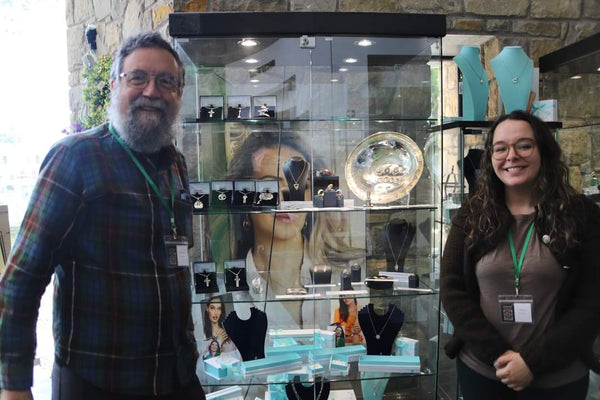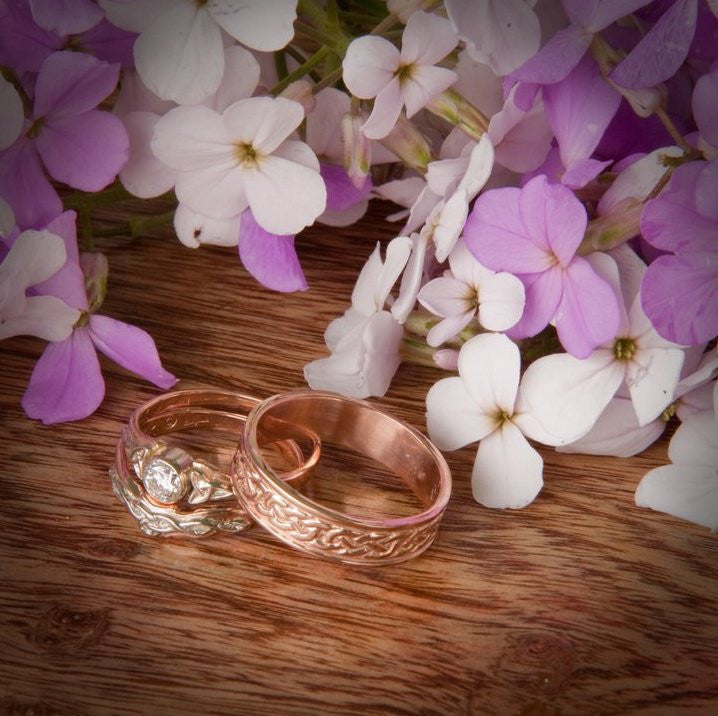
The wedding ceremony in modern western traditions tends to have more in common from one nation to another than there are differences. Even most of the prevalent customs such as the bride’s white dress, rings, wedding cake, flowers and attendants as well as the feast and pranks played on the couple as they make their final exit are pretty much universal. Every ethnic group has it’s own peculiar customs and variations but if we were to drop in on a wedding in a strange land where we did not know the language, be it Lebanon, Finland, Argentina or the remotest and most Gaelic island of the any of the Celtic nations, we would probably have a pretty good idea of what was going on. In planning a wedding with a Celtic theme or incorporating traditions from a Celtic heritage, the basics of your ceremony will be what the Church and State insist upon. Your wedding will be special regardless of the trappings and ornaments you choose because it is your wedding and because of that special person who you are promising yourself to. Weddings are a time when families look back at their roots and dream about their future. Our customs and traditions are one way we express who we are.

If you research quaint marriage customs from the past, much of what you will find describes the folk ways of largely pastoral, rural or village people. Courtship is under the scrutiny of parents, family elders or match-makers, although escaping that scrutiny has been a challenge that was frequently and boldly accomplished both in fairy tales and in real life if boys and girls have had eyes for each other. After consent and eligibility are established and the date is set, preparations for the festivities centers mostly around preparing to entertain and provide refreshment for the guests. In this way little has changed. In the old days most couples grew up within close distances and the gathering of guests would probably draw friends and relatives who would might travel for many hours to attend, by walking perhaps twenty or thirty miles. Feasting, drinking, dancing, drinking, blessings, gifts and drinking would occupy two or three days. Well, maybe not everyone did that much drinking, but the Celts do have a reputation. The details vary as location and time period change. Except for the twenty mile hike, when people who grow up in small communities marry one another, little has changed.
What has changed for many is that as modern people live and move in areas of greater population density and with more frequent migrations between communities, it has become increasingly unlikely that the bride and groom’s families already know each other, much less live in the same neighborhood. Couples are likely to come from different religious, social or ethnic backgrounds. The melting pot of a mobile modern society has tended to dilute our traditions. Meanwhile a whole industry has grown up catering to various aspects of weddings and encouraging extravagance and novelty. Rather than follow the strict script of simpler times we have many more choices in how we now conduct our weddings.

If you compare a wedding to a meal, the entrée, that is the meaning of the vows is one of the great bedrocks of our culture, unchanged for centuries. The choices of side dishes and condiments however have multiplied geometrically in the past half century.
Many of the rustic wedding customs of our ancestors do not travel very well to our present times. If you break a short bread over the head of the bride or groom as they leave the church what are the chances that the unmarried youths present will scramble to eat a bit of it off the ground to insure a good match for their own marriage? Cutting the cake over the seated bride’s head at the reception has replaced this tradition. It was also customary to salute the bride and groom by firing guns in the air outside the church. Try that in the suburbs! If you did have your wedding at a venue where you could use firearms, what statement would you be making? Chances are at least some of your guests would think you are a gun nut rather than a traditionalist. Honking the horns of the cars in the procession from the church replaces the guns.
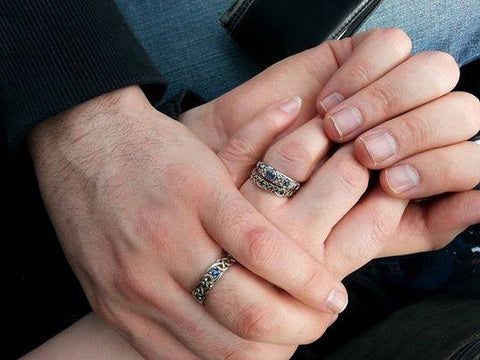
In some locations the couple would spend their wedding night in the barn. The bride’s girl-friends would dress her for bed and tuck her in and then the male guests would enter and kiss her good night. Great sport was made of delaying and harassing the groom before he could join her. The couple could then expect pranks and peeping until everyone was too drunk or exhausted to remember. Our grandparent’s generation planned their weddings with escape in mind from this kind of tradition. The tin cans tied to the get-away car evolved from this custom. Kidnapping the bride or groom is occasionally still attempted at some of the rowdier weddings. The salmon leap was the traditional way the groom joined his bride in the wedding bed. To do this he should crouch on the floor and then spring into bed in a single leap symbolically imitating a salmon swimming upstream to spawn.
There are old customs for good luck that are fun to follow. "Something old, something new, Something borrowed, Something blue, Silver sixpence in her shoe" (or "a penny in her shoe") is fairly well known. For people of Celtic heritage who live in new lands this is an opportunity to include something sentimental that relates to their heritage. An heirloom from the old country, if available can be used as something old or something borrowed. An Irish coin, or for Scots and Welsh an old British sixpence or penny can be worn in the shoe. Stock up now, the Euro-Dollar will not be as poetic. Something new items also can be chosen for their cultural significance also. Keep in mind the theme of continuum that a heritage wedding implies. With an eye to the future, the brooch or pendant that is something new for the present wedding can be loaned at a future wedding and might be the something old at the wedding of your daughter or granddaughter.
It is bad luck for the bride and groom to meet on their wedding day before they meet at the church. It is good luck to take a different route leaving the church than arriving at the church. This signifies that life is different now for the bride and groom.
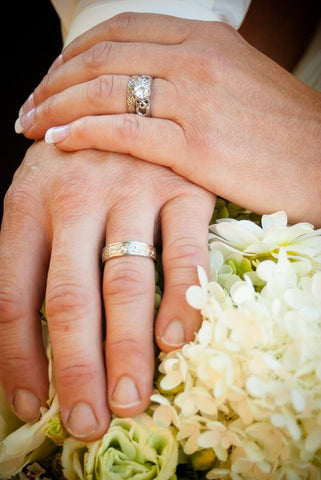
Musical traditions travel through time much better. Having a piper lead the bride to the church or down the aisle is a certain and reliable way to dress the occasion with heritage. This is probably the most common way to honor the bride and groom that gives the wedding a Celtic flavor. There is no single standard way to incorporate a piper in the wedding. Piping arrival or departure is the most common and goes back to the tradition of clan chiefs having personal pipers leading them with ceremonious fanfare. Sometimes they play outside as guests arrive or afterwards as the receiving line forms. If communion is served at a wedding, a piper or other Celtic musician can play during that time also or pipers can play a wedding march processional and/or a recessional. You can find a bagpiper almost anywhere in the world at by searching at sites like gigmasters.com

Celtic music at the reception is another great idea. A ceileigh band that can play for dancing is great fun or there are groups that specialize in mellower sorts of Celtic music. Pipers again are frequently engaged to play when the couple arrives at the reception site, during drinks before the meal or as the couple leaves the reception. Hiring a piper to play as you leave the reception can be difficult to arrange if you do not want to lock yourself into an exact time, but it is one of the most traditional times.

Wedding clothes are another opportunity to incorporate some tradition. The bride’s white gown has become so traditional that many cannot imagine anything else but this is relatively recent development in the Celtic lands. The white dress is a cosmopolitan fashion that has become practically universal in these days of mass communication. In the 19th century colored bridal dresses were quite common at country weddings. Kilts for the groom and attendants can be hired for weddings if they do not own their own. This is commonly done in Scotland these days and kilt hire is becoming available in other parts of the world as well. The wearing of kilts by those who were not brought up to it, and especially outside of Scotland should be considered carefully and thoughtfully. A man should not consider wearing a kilt for the first time at his own wedding if he thinks it might make him feel awkward or foolish. It takes a certain bearing to wear a kilt with confidence. The groom will probably have enough butterflies in his stomach just because he is getting married. The book So You Want to Wear the Kilt by Scotty Thomson is recommended reading.


In Scottish weddings where clan ties are strongly felt it is customary for the groom to pin a plaid or sash of his family tartan on his bride after the exchange of rings. Celtic design or traditional dress can be incorporated into the attire of the bride’s maids’ dresses as well or their jewelry.
History of Holy Matrimony
In the Gospel according to John we are told of Jesus’ miracle of changing the water to wine at a wedding in Cana. What does this account teach us about weddings? The Gospel says nothing about who was married or how their ceremony was conducted. The gospels have a lot to say about married life and divorce but the situation at the wedding at Cana leading to the miracle was that things were going badly because they ran out of wine. We learn from this incident that the wedding is a party and that the guests as well as host and the servants all consider it a very important party. Jesus’ mother is worried that the groom will be disgraced when the wine runs out early. She asks Jesus to do something about it. He fixes things and lets the groom get the credit from the guests who compliment him that his wine is so good.
Weddings are a unique moment when the bride and groom are the center of attention at a party that they and their family offers to their friends and relatives. The guests honor the bride and groom by enjoying the affair. As the wedding at Cana shows, a wedding cannot be allowed to become a social crisis. This is why families that are putting on weddings are so nervous about the details. A wedding is perhaps the most important social situation that the bride and groom will ever face. No one is waiting or hoping for the bride and groom to goof it up, in fact friends and guests will go to extraordinary lengths to be sure that they have a good time. This is a way of honoring the couple. We may not be capable of performing divine miracles to ensure that things go well or are we? Couples facing glitches at weddings almost always land on their feet, mainly because everyone is in agreement that they must. The people who love them most are not about to stand by and let them lose face. The pranks and goofiness that we associate with weddings are never mean spirited, in fact they do a lot to help relieve the tension. The wedding at Cana teaches us to relax and enjoy ourselves when a couple is being wed.
Weddings and marriage were nothing new at the time of Christ. This article examines the history of Christian matrimony as it relates to the wedding customs that developed in the Celtic lands.
The big wedding is not the only way to become man and wife. Eloping, marrying in a private ceremony or just shacking up until everyone thinks of you as married have all been practiced with various levels of acceptance or disapproval over the centuries.
Medieval marriages were, at least in theory, sanctioned and governed by the Christian church. The doctrine of the sacramental nature of marriage maintained that the institution was (and still is) a vehicle of divine grace. Early formalities of church weddings consisted quite simply of the couple meeting at the door of the local church, but outside it, to receive the blessing of the priest. Marriages that were not blessed by the church were still considered valid and in remote areas where priests were scarce people were still married. Marriages that were entered into informally were frowned on by the church, but the concept of "Common Law" marriages existing simply because the parties lived as man and wife were relatively common. The Council of Trent in 1563 established the requirement that the celebration of a marriage must be blessed by a priest before at least two witnesses. Both civil and ecclesiastical laws governing marriage in European countries evolved to discourage informal and secret marriages.
Banns of marriage were required in areas under British rule, including Wales, Scotland and Ireland. The banns consisted of an announcement in church for three Sundays prior to the wedding. This prevented people from marrying in haste and also gave any who might object time to learn of the match. Giving a fortnights notice to the registrar is still a legal requirement in Britain. Three months is required in Ireland. Waiting periods are common in most jurisdictions of the English speaking world, with the famous exception of the State of Nevada.
Banns were a much more thorough way of asking anyone who might object to "speak now or forever hold your peace." If you ever wondered what objections were valid they are that either of the parties are already married, they are under the age of consent, they are too closely related or if either has concealed injury or disease that would make it impossible for them to have children. These are also grounds for annulment.
At the time of the Protestant Reformation, Ireland , Scotland and Wales were all under English rule. Canon Law, the law of the church governing marriage was no longer universal. King Henry VIII broke with the Roman Catholic Church in part so that he could rewrite marriage laws and divorce Catherine of Aragon. The creation of new Established Churches lead to hardship and resentment by those who remained loyal to the old Catholic faith as well as other sects that emerged. Catholic family history can be difficult or impossible to trace since their weddings and baptisms were not registered in the Established Church and were therefore not accorded the same status of public record. This situation was improved in the mid 1800’s when marriages performed by secular registrars as well as ministers of religious communities other than the official state church were granted full legal recognition in the United Kingdom.
In Scotland Marriage by Declaration was once quite common and remained legal and valid until 1939. All that was required was that the couple declare their intentions before two witnesses. The problem with Marriage by Declaration was that occasionally there were misunderstandings and deceptions that proved messy. Issues of sobriety at the time of the declaration as well as possibility of misunderstandings about whether the declaration was of betrothal or actual marriage could put the relationship in doubt, lacking reliable witnesses. Since the transaction was informal and unrecorded it could be difficult to prove the legitimacy of offspring and rights of inheritance if either party abandoned the relationship. Eligibility to marry could be cast in doubt if a previous marriage was alleged but could not be proved. The old practice of English couples running off to Gretna Green at the Scottish boarder to be married by the blacksmith, under the more expedient Scottish law presents an exciting and romantic scenario. Gretna Green is still a very popular wedding destination but nowadays prior notice must be filed with the local registrar.
Our knowledge of what common folk did at their weddings prior to living memory is limited to a very few accounts recorded by travelers in the 19th century. Prior to then what the common folk did was of no interest to the literate. Many married with very little fuss. Established Church records are very good for weddings and baptisms going back well into the 18th century. It is quite common for baptisms and marriages to be recorded on the same dates which leads one to conclude that many couples sort of drifted into marriage and made it official only after the fact of their relationship was manifested in a flesh and blood child. On the other hand betrothals could be cause for celebration and often as formal an occasion and good time a party as the wedding itself. Just as today some people got married quietly while others made the event a memorable celebration that involves many friends and relatives.
Dave "The Exile" describes a typical Scottish wedding circa 1950, from the SCT-INVERNESS Genealogy Mailing List:
The banns were read, and posted over the appropriate period, the couple turned
up, were married, stopped for photos on the church steps, then got in the car,
threw out haepennies for the kids and sped off to the reception where they got
drunk, there was a fight, the women cried, the men laughed, the pipes played,
drunks spewed, women yelled at their men and eventually dragged them home, there
was dancing drinking and feasting. Just like everywhere else. (Remember a
Scottish funeral is merrier than an English wedding.) I was shocked at my first
Canadian, and then American weddings. People were so well behaved. Ach well then
the piper started and it was back to life as normal.
Handfasting
Much has been made of the revival of the custom called handfasting, perhaps too much. In some places and times (Medieval Scotland, Northern England and perhaps Ireland) it seems to mean betrothal and in others genuine marriage. Many interpret it as a trial marriage or a step beyond betrothal but not nearly as permanent as marriage. It is often repeated that this handfasting is for a year and a day.
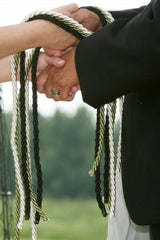

Appealing as the "trial marriage" concept of handfasting is to many, the "revival" of the practice is a case of life imitating fiction. The literary source for the "year and a day" originally comes from Sir Walter Scott. The popular Outlander series by Diane Gabeldon is just one of more recent examples of ideas about handfasting entering the popular imagination through historical novels. A year and a day was the period that a couple must be married for a spouse to have claim to a share of inheritable property in case of the death of the other spouse. Misunderstanding of this fact combined with confusion about the celebration of betrothals in medieval times lead to the modern myth of the Celtic trial marriage.
Never-the-less the mythical "trial marriage" handfasting is now pretty well established in some circles. Handfasting, according to the historical novel tradition would normally lead to regular permanent and valid marriage but if either parties chose to leave, the relationship was null. Even if children had been brought forth these children were considered lawful offspring of both parents. Neither would be prevented from seeking marriage to another after the handfasting was dissolved. Handfasting in a manner reminiscent of marriage by declaration is advocated by modern pagans and historical reenactment enthusiasts, sometimes as an off-the-books substitute for legal marriage, sometimes as a supplement to a legal wedding. Handfasting, it is claimed is a holdover from pre-Christian Celtic marriage laws. It should not be surprising that in this day and age when sexual partnerships often avoid the commitment of permanent monogamy, that a fantasy state of non-marriage should appear. If trial marriages existed in medieval times as it is claimed, they were just the sort of unregistered, off-the-books affairs that would be impossible to document historically. Thus the possibility that such arrangements once may have been is used to justify arrangements that are made to order for lovers wishing to live together in a partnership recognized by like-minded friends, but without the blessing of church or state.
Handfasting can be part of the religious or civil wedding ceremony. The hands of the bride and groom are joined as in the familiar scene as the person officiating the ceremony asks "Who gives this woman to be wed?" and then takes her hand from her father or whoever is giving away the bride and clasps it to the hand of the groom. In olden days the priest or minister would wrap the clasped hands in the end of his stole to symbolize the trinity of marriage; man and woman joined by God. With God’s grace in time another trinity would be manifest; mother, father and child. The Celts have always been good at seeing things in threes. This symbolic binding together in marriage evolved into a the practice of wrapping the clasped hands with a cord or an embroidered cloth, usually made especially for that purpose. Handfasting in this manner is a legitimate part of a legally valid marriage, rather than a substitute for it. More articles about Handfasting
It should be cautioned that while brides and grooms can be very creative with their vows, clothes, locations, music and religious content of their weddings, laws of the state and church still apply. It is a crime for clergy to knowingly perform marriages that would not be legally binding or to perform marriages and not record them properly with the state. If you ask a real ordained minister, who is licensed by the state to perform marriages, to bless a handfasting that you do not want to record as a legal wedding you are on very thin ice unless you make it very clear that it is a betrothal. Religious sects have rules about what they allow as well.
There are two reasons when it is OK and even advisable to have a second informal wedding ceremony that would not be registered with the state. When a couple joins or returns to active fellowship in religious faith after having been married outside that church they may be wed again according to the form and tradition of the sect they wish to have bless their marriage. This commonly happens when a couple wants their existing marriage to be recognized by the Roman Catholic Church, but they may desire to reaffirm their vows in a religious ceremony in any faith, either because they are just now converting to it or for some other reason they did not have a religious ceremony at the time they first wed. This wedding is usually done privately. It need not be recorded with the state since as far as the state is concerned the marriage already exists. It is increasingly popular to renew wedding vows, usually on an anniversary. This can be a very touching ceremony and again there is no need to record the event with the state or comply with any of the legal requirements of a regular wedding as the marriage is already recorded.
Comments will be approved before showing up.
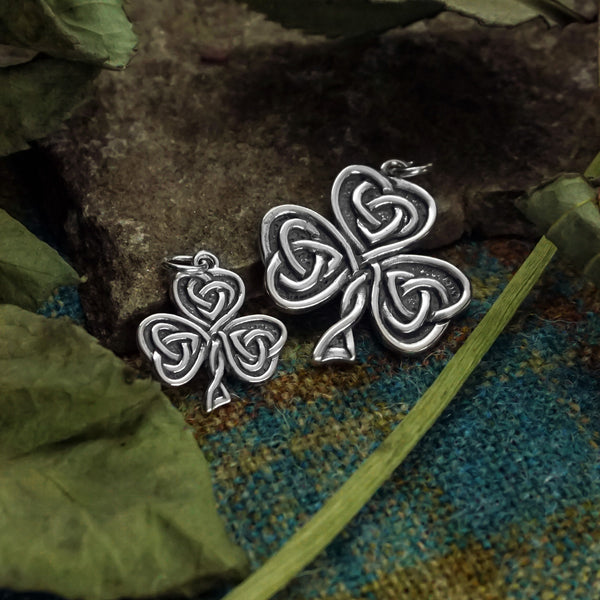
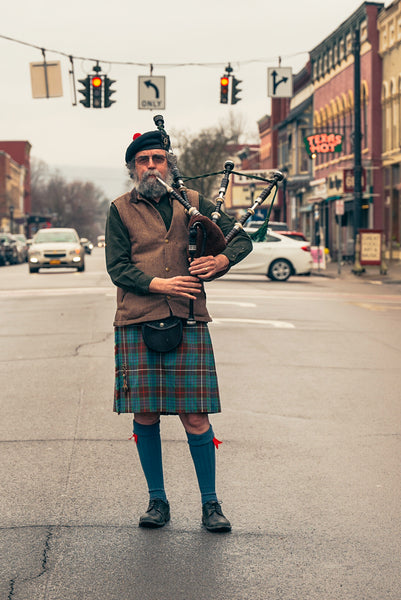
Thousands of photographs were taken. Help find at least one.
Were you a tourist in London, Dublin or Paris in 1975 – 1978? Did you see a street performer playing bagpipes? Did you take his picture? Was it Steve Walker? If you can share that picture with Walker Metalsmiths you could score some sweet Celtic jewelry.
